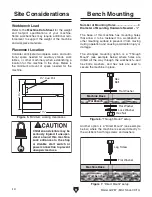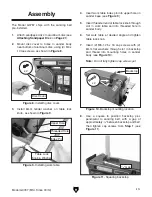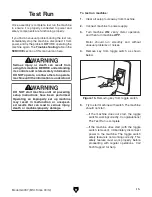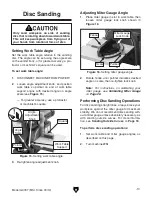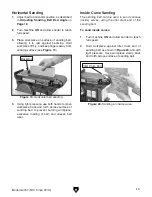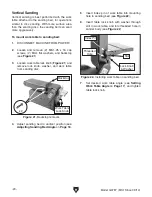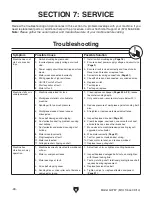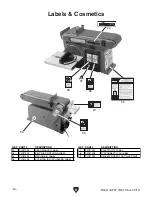
-26-
Model G0787 (Mfd. Since 09/14)
Review the troubleshooting and procedures in this section if a problem develops with your machine. If you
need replacement parts or additional help with a procedure, call our Technical Support at (570) 546-9663.
Note: Please gather the serial number and manufacture date of your machine before calling.
SECTION 7: SERVICE
Troubleshooting
Symptom
Possible Cause
Possible Solution
Machine does not
start or a breaker
trips.
1. Switch disabling key removed.
2. Incorrect power supply voltage or circuit
size.
3. Power supply circuit breaker tripped or fuse
blown.
4. Motor wires connected incorrectly.
5. Wiring open/has high resistance.
6. ON/OFF switch at fault.
7. Start capacitor at fault.
8. Motor at fault.
1. Install switch disabling key (
Page 16).
2. Ensure correct power supply voltage and circuit size
(
Page 9).
3. Ensure circuit is sized correctly and free of shorts.
Reset circuit breaker or replace fuse.
4. Correct motor wiring connections (
Page 31).
5. Check/fix broken, disconnected, or corroded wires.
6. Replace switch.
7. Test/replace.
8. Test/repair/replace.
Machine stalls or is
underpowered.
1. Machine undersized for task.
2. Workpiece material not suitable for
machine.
3. Sanding with too much pressure.
4. Workpiece crooked; fence loose or
misadjusted.
5. Drive belt damaged and slipping.
6. Dust collection ducting problem, causing
dust buildup.
7. Dust collector undersized, causing dust
buildup.
8. Motor wired incorrectly.
9. Plug/receptacle at fault.
10. Motor overheated.
11. Pulley/sprocket slipping on shaft.
1. Clean/replace sandpaper (
Pages 25 & 22); reduce
feed rate/sanding depth.
2. Only sand wood—ensure moisture is below 20%.
3. Reduce pressure of workpiece against sanding belt/
disc.
4. Straighten or replace workpiece/adjust fence.
5. Inspect/replace drive belt (
Page 29).
6. Clear blockages, seal leaks, use smooth wall duct,
eliminate bends, close other branches.
7. Move closer to machine/redesign ducting layout/
upgrade dust collector.
8. Wire motor correctly (
Page 31).
9. Test for good contacts/correct wiring.
10. Clean motor, let cool, and reduce workload.
11. Replace loose pulley/shaft.
Machine has
vibration or noisy
operation.
1. Machine incorrectly mounted to workbench
or floor.
2. Motor or component loose.
3. Motor bearings at fault.
4. Drive belt slapping cover.
5. Sanding disc or drive roller out of balance,
damaged, or loose.
1. Adjust feet, shim, or tighten mounting hardware.
2. Inspect/replace damaged bolts/nuts, and retighten
with thread locking fluid.
3. Test by rotating shaft; rotational grinding/loose shaft
requires bearing replacement.
4. Replace/tension drive belt.
5. Tighten, adjust, or replace affected component
(
Page 21).
Summary of Contents for G0787
Page 40: ......

